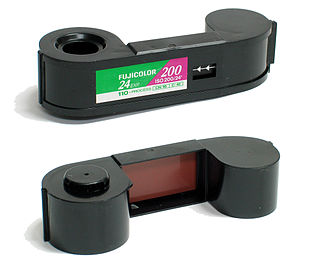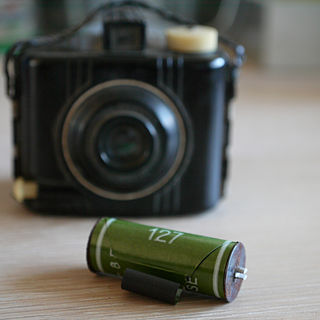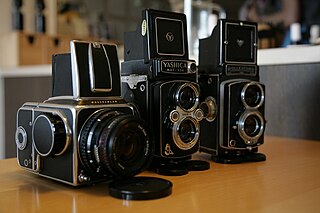 W
WA film format is a technical definition of a set of standard characteristics regarding image capture on photographic film, for either stills or filmmaking. It can also apply to projected film, either slides or movies. The primary characteristic of a film format is its size and shape.
 W
W4DX is a 4D film format developed by CJ 4DPlex, a subsidiary of South Korean cinema chain CJ CGV. It allows films to be augmented with various practical effects, including motion seats, wind, strobe lights, simulated snow, and scents. First introduced commercially in 2009, it presents films in both 3D and traditional 2D formats.
 W
W17.5 mm film was a film gauge for as many of eight types of motion picture film stock, generally created by splitting unperforated 35 mm film.
 W
WThe 35 mm format, or simply 35 mm, is the common name for the 36×24 mm film format or image sensor format used in photography. It has an aspect ratio of 3:2, and a diagonal measurement of approximately 43 mm. It has been employed in countless photographic applications including single-lens reflex (SLR) cameras, rangefinder cameras, mirrorless interchangeable-lens digital cameras, digital SLRs, point-and-shoot film cameras, and disposable film cameras.
 W
W35 mm film is a film gauge used in filmmaking, and the film standard. In motion pictures that record on film, 35 mm is the most commonly used gauge. The name of the gauge is not a direct measurement, and refers to the nominal width of the 35 mm format photographic film, which consists of strips 1.377 ± 0.001 inches (34.976 ± 0.025 mm) wide. The standard image exposure length on 35 mm for movies is four perforations per frame along both edges, which results in 16 frames per foot of film.
 W
W110 is a cartridge-based film format used in still photography. It was introduced by Kodak in 1972. 110 is essentially a miniaturized version of Kodak's earlier 126 film format. Each frame is 13 mm × 17 mm, with one registration hole. Cartridges with 12, 20, or 24 frames are available on-line. Production variations sometimes have allowed for an additional image.
 W
W120 is a film format for still photography introduced by Kodak for their Brownie No. 2 in 1901. It was originally intended for amateur photography but was later superseded in this role by 135 film. 120 film and its close relative, 220 film, survive to this day as the only medium format films that are readily available to both professionals and amateur enthusiasts. As of December 2018 all production of 220 film has stopped/paused worldwide. The only remaining stocks are from the last Fujifilm production run (2018) and they are mostly found in Japan.
 W
W126 film is a cartridge-based film format used in still photography. It was introduced by Kodak in 1963, and is associated mainly with low-end point-and-shoot cameras, particularly Kodak's own Instamatic series of cameras.
 W
W127 is a roll film format for still photography introduced by Kodak in 1912.
 W
W135 film, better known as 35 mm film, is a format of photographic film used for still photography. It is a cartridge film with a film gauge of 35 mm (1.4 in), typically used for hand-held photography in 35 mm film cameras. Its engineering standard for the film is controlled by ISO 1007.
 W
W120 is a film format for still photography introduced by Kodak for their Brownie No. 2 in 1901. It was originally intended for amateur photography but was later superseded in this role by 135 film. 120 film and its close relative, 220 film, survive to this day as the only medium format films that are readily available to both professionals and amateur enthusiasts. As of December 2018 all production of 220 film has stopped/paused worldwide. The only remaining stocks are from the last Fujifilm production run (2018) and they are mostly found in Japan.
 W
W828 is a film format for still photography. Kodak introduced it in 1935, only a year after 135 film. 828 film was introduced with the Kodak Bantam, a consumer-level camera.
 W
WAdvanced Photo System (APS) is a discontinued film format for still photography first produced in 1996. It was marketed by Eastman Kodak under the brand name Advantix, by FujiFilm under the name Nexia, by Agfa under the name Futura and by Konica as Centuria.
 W
WDisc film is a discontinued still-photography film format that was aimed at the consumer market. It was introduced by Kodak in 1982.
 W
WFilm gauge is a physical property of photographic or motion picture film stock which defines its width. Traditionally, the major movie film gauges are 8 mm, 16 mm, 35 mm, and 65/70 mm. There have been other historic gauges in the past, especially in the silent era, most notably 9.5 mm film, as well as a panoply of others ranging from 3 mm to 75 mm.
 W
WA half-frame camera is a camera using a film format at half the usual exposure format. A common variety is the 18×24 mm format on regular 135 film. It is the normal exposure format on 35mm movie cameras. For still cameras using the 35mm film, the usual format is 24×36 mm, so still cameras taking 18×24 mm exposures are called half-frame cameras.
 W
WInstant film is a type of photographic film that was introduced by Polaroid Corporation to produce a visible image within minutes or seconds of the photograph's exposure. The film contains the chemicals needed for developing and fixing the photograph, and the camera exposes and initiates the developing process after a photo has been taken.
 W
WInstax is a brand of instant still cameras and instant films marketed by Fujifilm.
 W
WLarge format refers to any imaging format of 4×5 inches (102×127 mm) or larger. Large format is larger than "medium format", the 6×6 cm or 6×9 cm size of Hasselblad, Mamiya, Rollei, Kowa, and Pentax cameras, and much larger than the 24×36 mm (0.95×1.42 inch) frame of 35 mm format.
 W
WMedium format has traditionally referred to a film format in still photography and the related cameras and equipment that use film. Nowadays, the term applies to film and digital cameras that record images on media larger than 24 mm × 36 mm (full-frame), but smaller than 4 in × 5 in.
 W
WMicroforms are scaled-down reproductions of documents, typically either films or paper, made for the purposes of transmission, storage, reading, and printing. Microform images are commonly reduced to about 4% or one twenty-fifth of the original document size. For special purposes, greater optical reductions may be used.
 W
WMicroprinting is the production of recognizable patterns or characters in a printed medium at a scale that requires magnification to read with the naked eye. To the unaided eye, the text may appear as a solid line. Attempts to reproduce by methods of photocopy, image scanning, or pantograph typically translate as a dotted or solid line, unless the reproduction method can identify and recreate patterns to such scale. Microprint is predominantly used as an anti-counterfeiting technique, due to its inability to be easily reproduced by widespread digital methods.
 W
WA real photo postcard (RPPC) is a continuous-tone photographic image printed on postcard stock. The term recognizes a distinction between the real photo process and the lithographic or offset printing processes employed in the manufacture of most postcard images.
 W
WRollfilm or roll film is any type of spool-wound photographic film protected from white light exposure by a paper backing, as opposed to film which is protected from exposure and wound forward in a cartridge. The term originated in contrast to sheet film. Confusingly, roll film was originally often referred to as "cartridge" film because of its resemblance to a shotgun cartridge.
 W
WScreenX is a panoramic film format which presents films with an expanded, dual-sided, 270-degree screens projected on the walls in a theater. First introduced in 2012, it is created by CJ 4DPLEX, a subsidiary of the CJ CGV group which also created the 4DX motion-theater technology, which, in fact, uses a similar logo and combines both formats, known as "4DX Screen". Co-developed by KAIST, it is considered a "sideways" version of IMAX and a presumed competitor to streaming platforms such as Netflix. In addition to films, the ScreenX theater also shows advertisements filmed or converted for the format.